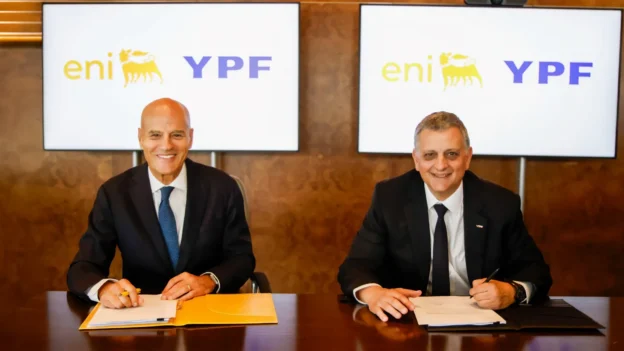In Buenos Aires, President Javier Milei met with the CEO of Eni S.p.A., Claudio Descalzi, to finalize a crucial technical step of the Argentina LNG project, which seeks to transform the country into a strategic exporter of liquefied natural gas, with direct impact on the national economy and international projection.
What is agreed with the signing of the FTPD?
Following the meeting, Eni and Yacimientos Petrolíferos Fiscales (YPF) signed the Final Technical Project Description (FTPD), a document outlining the key aspects of the first phase of the project. signed the Final Technical Project Description (FTPD), a document outlining the key aspects of the first phase of the project, a step prior to the expected Final Investment Decision (FID).
The first stage contemplates a production capacity of 12 million tons per year (MTPA) of liquefied natural gas through two floating liquefaction units (FLNG), where each will operate at 6 MTPA, equivalent to about 9 billion cubic meters of gas per year. The gas will be processed and liquefied for subsequent export, together with the associated liquids.
What are the roles of Eni and YPF?
The strategy contemplates a high-level synergy in which:
- YPF: Will be in charge of upstream operations, including drilling and production at the unconventional field Vaca Muerta .
- Eni: It will act as the international technological and strategic partner, contributing its experience in midstream operations with FLNG floating platforms, as well as part of the capital required for the development of the Argentina LNG project.
YPF’s CEO, Horacio Marín, estimated that the initiative will require the drilling of 800 new wells and a combined investment of 40 billion dollars, between infrastructure and field development.
What’s next: towards project implementation
It is estimated that exports of liquefied natural gas and liquids associated with the project could reach between $14 billion and $20 billion annually, a massive injection of foreign exchange for the country. In addition, if the deal goes through, tens of thousands of jobs will be generated, creating a strong inflow of foreign exchange, which could improve the country’s domestic political position.
This partnership is a clear example of a strategic collaboration in which each party brings its core strength; YPF contributes the resource and local presence, while Eni provides the technology, capital and global expertise needed to turn that resource into an export product.
Source: Eni.

